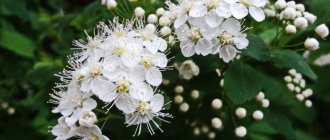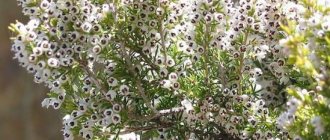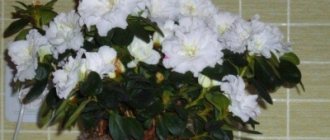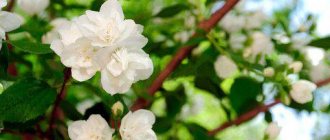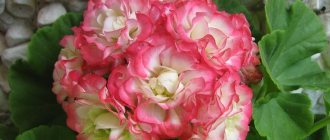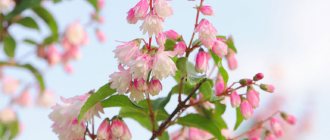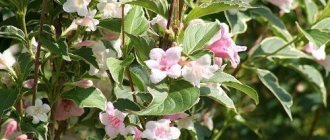Spiraea arguta (sharp-toothed) is a beautiful, unpretentious, winter-hardy deciduous shrub of the Rosaceae family. Falling thin branches, densely sprinkled with elegant white flowers along almost the entire length, give the spirea the appearance of a bride in an openwork veil, obediently awaiting her Pygmalion to become even more beautiful. Its flowering period is short, but very bright: Spiraea arguta wears its wedding dress from late April to June, attracting the attention of romantics and sophisticated lovers of stylish landscape design.
It reaches 2 m in height and has a spreading crown with narrow jagged leaves up to 4 cm long. It grows slowly (15-20 cm per year), blooms on the shoots of the previous year, perfectly tolerating pruning, dry soil and partial shade, although in bright sunlight and the free space around it looks most impressive. If you like the festive exterior and undemanding nature of Spiraea arguta, read on to learn how to make it a decoration for your garden plot.
Description of Argut spirea
Spirea Arguta (spiraea arguta) is an ornamental shrub from the Rosaceae family. To create this hybrid, 2 species were used: Thunberg spirea and multifloral.
The shoots of an adult plant grow up to 2 m; the branches can spread up to 3 m in diameter. The leaf blades are narrow, lanceolate in shape. Sharp serrations are clearly visible on the dark green leaves. The branches of Argut spirea are thin and bend in the form of an arc.
At the end of May and almost until the end of June, meadowsweet bushes are covered with white flowers. Long umbrella-type inflorescences are formed on shoots for 2 years.
Diameter of buds – 8 mm, petals – 5 pcs. Inside each flower there are a large number of stamens, due to which it becomes fluffy. When flowering begins, the leaves are practically invisible, and the branches droop under the weight of the inflorescences. And the whole space is filled with a honey aroma.
The development of the Argut spirea bush is slow; shoots grow by 10-20 cm per year, but regardless of this, the plant must be pruned.
Spiraea Arguta is widely used by landscape designers for single plantings and creating hedges. The shrub can be found not only in garden plots, but also in large parks. The plants look advantageous against the background of conifers.
Comment! The shoots of spirea contain a substance - the glycoside salicin, from which aspirin began to be produced back in 1939.
Description of the bush
This hybrid was created using two species: Spiraea Thunberg and multiflorum. Arguta produces shoots reaching 2 m, while the diameter of the bush is up to 3 m.
The leaf blades of the shrub are narrow, jagged at the edges, intense green in color and up to 4 cm long. Thin curving branches form beautiful arcs, covered with abundant white inflorescences. It blooms for a month, starting from the third ten days of May.
Snow-white buds with a diameter of 0.8 cm, blooming on two-year-old shoots, are united in umbrella-type inflorescences. Inside the blossoming flower there are many stamens that give fluffy volume to the abundantly flowering branches. During flowering, the bush emits a honey smell.
Did you know? Spiraea shoots contain the glycoside salicin, which is why they became the first raw material for the production of aspirin in 1839.
Spiraea Argut is very similar to Spiraea gray and Spiraea Vangutta. The only difference between them is in the shape of the crown: in the Vangutta variety it is cascading, the leaves are wider, and the inflorescences are rarer, in the Argutta variety it is more spreading, in the gray variety it is loose and lacy. Gray Spiraea has gray foliage and flowers, and Vangutta sometimes blooms a second time in late summer.
Peculiarities
Spiraea arguta is an ornamental hybrid shrub belonging to the Rosaceae family. The description of the variety says that it is a combination of two varieties of spirea - multifloral and Thunberg. The shrub reaches a height of 2 meters, and its diameter can reach 3 meters. The leaves of Spiraea argut are quite narrow, have a rich green color and peculiar teeth, due to which it is often called “sharp-serrated”.
The length of the plate is 4 centimeters. The thin branches of the plant naturally form arches.
Flowering occurs from late spring until the last days of June. At this time, snow-white buds, united in umbrella inflorescences, open on the bush. The diameter of one bud is 8 millimeters, and it is formed from 5 petals. The presence of stamens inside helps create the fluffy effect of flowers.
The flowering of Argut spirea is abundant and very beautiful, accompanied by the appearance of a honey smell. New flowers appear on last year's shoots.
The length of the branches increases by only 10-20 centimeters per year, but the shrub still requires regular pruning. The culture is unpretentious and frost-resistant, withstanding temperatures dropping to -40 degrees.
Why does spirea need pruning at all?
Pruning spirea for beginning gardeners is an adventure. What if this event harms the shrub, and it reacts painfully to pruning - it begins to dry out? What if his appearance is irreparably damaged? Don't worry, nothing like that will happen. The bride will with renewed vigor delight everyone who sees her with her extraordinary beauty.
Pruning spirea is necessary and useful for the following reasons:
- Air circulation inside the bush improves. The bush is less exposed to invasions of various insects, and the risk of fungal diseases is significantly reduced.
- The decorative qualities of the plant increase, since the gardener removes dry and crooked shoots, cuts off everything that gets in the way, sticks out and destroys the created image.
- After pruning, the plant receives an additional incentive to form new shoots.
- Spiraea develops, its flowering becomes more abundant and luxuriant.
It turns out that pruning is a mandatory procedure that accompanies the normal development of decorative crops. Spiraea recovers quickly, so all mistakes made by novice gardeners can be easily compensated for.
Planting and caring for Argut spirea
Spirea seedlings can be planted in spring or autumn, before frosts begin. In order for the plant to take root well, choose a cool, preferably cloudy day.
Important! Plants in containers can be planted at any time.
Spiraea grows on any soil, but the shrub develops better if you add leaf or turf soil, peat, and sand to the hole when planting.
Meadowsweet is an unpretentious shrub that does not require special care. But when choosing a location, preference is given to openwork shade. Frost-resistant spirea can withstand temperatures down to -40 degrees.
Application in landscape design
Thanks to its unpretentiousness, Arguta is an excellent option for urban landscaping. There it is often used as hedges. In small private landscapes it looks great in single plantings. The shrub is especially good against the backdrop of a lawn or next to coniferous plantings.
Find out also what spirea is combined with in landscape design.
With good care, Spiraea Arguta can last you up to 25 years. It is hardy, tolerates short-term droughts and winters well and does not require special care. It is often used by people who do not have the opportunity to devote a lot of time to caring for plants in their garden.
Preparation of planting material
The survival rate and development of the shrub depend on the quality of planting material. You can use seedlings with open and closed root systems. If young bushes were grown in containers, then they are well watered before planting in order to pull out the seedling along with a lump of earth.
Plants with an open root system are specially prepared:
- For a day, soak in a solution of potassium permanganate or any composition that stimulates root development.
- If this part of the plant is too long, it is shortened with a sharp tool to 20-25 cm. It is important that the cut is even.
- The shoots also need to be shortened for all Argut spirea seedlings, leaving no more than 4-5 living buds for rooting to be successful.
- Argut spirea seedlings (as in the photo below) can be grown independently, as the shrub reproduces well, or purchased from nurseries.
How to plant?
Planting of argut spirea occurs either in the spring after the end of frosts, or in the fall, respectively, before the start of frosts. Ideally, the procedure should take place on a cloudy day with relatively low temperatures. Container plants cannot be planted at any time. Although spirea can grow on any surface, experts recommend adding turf or leaf soil, as well as sand and peat, to the hole. The place should be shady.
Saplings with an open root system are prepared in a slightly different way. 24 hours before the planned planting, soak in a manganese solution or a root stimulator. If necessary, the roots are shortened with a disinfected and sharpened knife to a length of 20 to 25 centimeters. The cut must be even. The shoots are shortened so that only 4 to 5 buds remain along the entire length.
The area where Argut spirea will be planted is dug up, weeded and cleared of the remains of other plants, as well as weeds. The hole is created in such a way that its dimensions are a couple of times larger than the dimensions of the root system. If shrubs are planted separately, then a gap of one to a couple of meters should be maintained between them. When creating a hedge, the distance between seedlings is 70-80 centimeters.
A small hill is built in the central part, on which a spirea seedling is placed. The roots are straightened and covered with soil so as not to cover the root collar.
Arguta is irrigated, but it is important to ensure that the water does not drag the seedling down. The root area is immediately mulched using peat or humus
Landing rules
After choosing a site for planting single spirea bushes, in combination with other trees or hedges, you need to start preparing. The earth is carefully dug up, weeds and roots are removed.
After this, dig a hole 2 times larger than the root system. For single plantings, 1-2 m are left between spirea bushes. To create a hedge, seedlings are planted at a distance of 70-80 cm.
Planting stages:
- The bottom of the dug hole is filled with 10-15 cm of drainage (large pebbles, broken bricks).
- The rest of the planting area is filled with fertile, loose soil.
- The earth is watered and allowed to go deeper.
- A small mound is made in the center of the pit, on which a spirea Argut seedling is placed.
- Carefully straighten the roots and cover them with soil so as not to deepen the root collar.
- Water the plant, then lightly tug the seedling if it is pulled down during planting.
- The root zone is sprinkled with mulch (peat or humus) to retain moisture.
Planting a plant
There are two ways to plant a spirea bush in the garden - grow it from seeds or from seedlings.
Seeds
Spirea Grefsheim - description, planting and care
This method of growing is not very popular among amateurs. The plant is grown using seeds only in nurseries. This is quite easy to do, but it is very likely that the specific characteristics of the mother bush will not be transferred to the new plant.
Seeds are planted with the onset of spring, but the first shoots will appear only after 3-4 months. When several leaves appear on the shoot, the seedlings are plucked and left in separate containers until autumn. Spiraea grown from seeds will begin to bloom no earlier than after 3 years.
Additional Information! With the appearance of the first leaves, the seedlings can be planted in open ground in a seedling bed. However, then they need to be covered with film and moved to a permanent place in the spring.
Cuttings
This is the simplest method in which all the properties of the mother bush are preserved. It is necessary to cut cuttings for seedlings in early June. To do this, select annual semi-woody shoots. They must have at least 5 leaves.
Before planting, the cuttings are placed in a root solution for 12 hours. You can place it either in a pot with light soil or in prepared open ground. After this, the seedling must be covered with film.
While the cutting is taking root, it needs careful care. It is necessary to keep the soil not too wet, but not too dry. The seedling should be regularly ventilated and sprayed. It is better to keep the plant in a shaded place. In the spring, when young shoots appear, the bush is transplanted into permanent soil.
Watering and fertilizing
Further care for spirea is no different from the measures that are necessary for deciduous shrubs.
After planting, the plants need systematic watering, but there is no need to bring the soil to the state of a swamp. Emerging weeds are removed, as they can cause diseases and pests. For fragile plants, such a neighborhood is dangerous.
If there is no rain, adult shrubs are watered once a week. Each bush will require 1.5 buckets of water. After watering, the soil in the root zone is loosened shallowly so that oxygen reaches the roots, and mulch is added.
Care
Periodically loosen the soil in the spirea tree trunk, combining it with watering and weeding. This is very important for young plants. It is also important to do timely pruning and protect spirea arguta from severe frosts, despite its frost resistance.
Watering. Water the spirea once a week, one plant needs about 15 liters of water, in dry summers - once every three days, and in normal weather - once every seven or eight days. The amount of water per watering is 15 liters. Before watering, loosen the soil, remove weeds, and after watering, mulch - for example, with peat neutralized by PETER PEAT from the AGRO line, otherwise the plant will not drink and will not have enough oxygen.
Trimming. Spiraea arguta, being a spring-flowering species of spirea, requires almost no pruning, with the exception of sanitary trimming: in the spring, immediately after flowering, remove old (over 5 years old), dried and damaged branches. You should not shorten faded shoots, because... this will increase the growth of side branches, and you will deprive the spirea of its main advantage - long flowing “hair”.
To form a bush in late March - early April, prune it, removing frozen and weak branches and leaving 5-6 of the strongest; to rejuvenate it, cut off all the old branches at the root (to the stump): this will give good development of shoots from dormant buds at the root collar.
Shelter. In harsh winters, the ends of the shoots of Argut spirea freeze: in the fall, protect the roots of the plant by covering the soil around the plant with a dry leaf, straw or peat with a layer of up to 10 cm. You can build something like a pyramid from long slats and cover this structure with lutrasil - this will protect the spirea from snow load and bush collapse.
Pruning Argut spirea
Spiraea sharp-toothed or Arguta must be pruned in order to properly form the crown of the bush. This procedure will benefit the meadowsweet, since the plant will then produce new powerful shoots, on which a large number of snow-white inflorescences will form next year.
In addition, pruning will give Arguta a decorative appearance, since you can create any shape for a deciduous shrub.
You also need to cut out some of the young shoots, of which many grow over the summer. If you leave them, the bush will look sloppy, and heavily thickened plantings suffer from diseases and pests.
Spirea pruning is carried out for different purposes, it can be:
- sanitary;
- stimulating;
- formative;
- rejuvenating.
Sanitary pruning
Drying of meadowsweet shoots begins in the 2nd year. They should not be left on the bush, as spores of diseases and pests can overwinter on them. Branches that did not survive the frosty winter must also be pruned. The sanitary procedure is carried out early in the spring, before the buds open.
Damaged shoots are also trimmed during the growing season.
Stimulating haircut
This type of shrub pruning is carried out in early spring, when the spirea is 3-4 years old. When pruning, weak shoots and branches are removed, the spirea begins to branch better, which promotes abundant flowering. The bush itself will become healthier and more attractive.
Formative pruning
You can form the crown of a bush in spring or autumn. With this pruning you can get bushes with the desired crown shape.
Depending on the age and condition of the bush, shaping haircuts can be done in different ways: moderately or strongly.
Bush rejuvenation
Old bushes that have been growing on the site for more than 15 years need rejuvenation. So that spirea does not lose its attractiveness and continues to delight with snow-white clusters of fluffy flowers, it needs to be pruned. Haircuts are performed 14-21 days before frost, so that the wounds have time to heal and do not freeze in winter.
Attention! In this case, the shoots are cut off at the root. The plant will give new growth in the spring.
How to properly care?
Caring for argut spirea consists of the usual stages inherent in most ornamental shrubs. Irrigation should be regular but moderate to prevent waterlogging of the soil. In the summer heat, plants should be watered once every 3 days, but if the weather is adequate, the frequency can be reduced to once a week. As a rule, about 15 liters of settled water have to be spent on one shrub, after which mulching and loosening of the surface must be carried out. If weeds appear near the spirea, it is recommended to weed them immediately, since their presence contributes either to the spread of insects or to contamination of the crop.
For shrubs, timely pruning is extremely important, the main task of which is to form the crown. In addition to the aesthetic effect, this procedure also contributes to the emergence of new strong shoots, which next year will be covered with snow-white buds. Be sure to remove most of the young branches that grew during the summer to avoid thickening. All pruning is divided into several varieties: sanitary, shaping, stimulating and rejuvenating.
Sanitary pruning begins in the second year of development of spirea argut. During this process, dried shoots that are carriers of pathogenic spores and insects are eliminated. Shoots that have deteriorated during the winter cold are also pruned. Therefore, sanitary pruning is carried out in early spring, while the buds of the plant have not yet opened. Additionally, damaged shoots will need to be removed throughout the summer.
Formative pruning should be done either in spring or autumn, and its main purpose is to create a beautiful shape for the crown of the shrub. In addition, we must not forget about the rejuvenation of bushes, which is necessary for spireas that have reached 15 years of age. This pruning is carried out a couple of days before winter frosts and consists of cutting off the branches directly to the root. When talking about caring for argut, one cannot fail to mention the application of fertilizers. The optimal composition is a mixture of organic substances, for example, compost, as well as mineral complexes. The thickness of the compost should vary from 5 to 7 centimeters, and 30 g of urea and 100 g of Kemira are suitable as mineral fertilizers.
Preparing for winter
Adult plants do not need special shelter, since, according to the description, Arguta shoots can withstand frosts down to -40 degrees. But the roots are located close to the surface and need protection. In autumn, compost or humus is applied under the bushes in a layer of at least 30 cm.
Young meadowsweet bushes up to 4 years of age need to be specially prepared for wintering. The root zone is sprinkled with mulch. The branches, while there is no frost, are compressed and tied with twine. Burlap or any non-woven material is pulled over the top.
general information
Spiraea got its name from its shoots that are surprisingly flexible for a shrub, because from ancient Greek this word literally translates as “bend.” People call the popular ornamental shrub meadowsweet, so it’s likely that you know it by this name.
Spiraea combines truly vital features for our latitudes. It is at the same time very unpretentious, resistant to severe frosts and blooms for a long time even on the hottest days.
There are dwarf spireas that barely stretch up to 20 cm and are well suited for rockeries. But there are also full-fledged tall shrubs 1-1.5, or even up to 2.5 m. The meadowsweet bark has an interesting natural feature - it can peel off. This is its natural life cycle, which periodically frightens inexperienced gardeners.
All spireas have shallow and superficial, but very developed fibrous roots. The branches and leaves can be of completely different types, but the flowers are often similar. They are small, but there are a lot of them, and they are always collected in large lush inflorescences. Shades range from snow-white to rich dark pink.
Tips for caring for a bush
To ensure that the flowering is abundant and the arguta does not lose its decorative beauty, it is worth using a few simple recommendations for caring for the plant.
Relation to temperature
Arguta can withstand summer heat and winter frost quite well. Even 40-degree frost will not be destructive for the plant. It is enough to cover it with foliage, as well as follow the basic principles of pruning, watering and fertilizing the soil, and carry out these manipulations in a timely manner in accordance with the temperature regime.
Soil and fertilizers
Arguta does not require frequent application of fertilizers to the soil. If nutrients were added during planting in sufficient quantities, then this volume will be enough for 1 year. Additionally, you need to apply fertilizer only after cutting off all the shoots almost to the root. To give the spirea strength, prepare a nutritious mixture of organic matter (50-70 cm thick) and mineral fertilizers (for example, “Kemiry”).
Watering and humidity
Spiraea needs to be watered systematically, but soil moisture should be moderate, this is especially important with mulched soil. During the summer heat or during a drought, watering is performed 1 time/3 days, and in normal weather and moderate precipitation - 1 time/1 week. Typically, approximately 15 liters of water are used at a time to moisten 1 bush. At the end of watering, the soil is mulched to prevent the formation of a crust on the soil surface.
Transplanting a plant
It is advisable to move the plant to a new location in spring or autumn. A sunny area with no draft is suitable for the culture. It is important to avoid low or wet areas.
Spiraea requires fertile soil; it must be acidic or slightly alkaline. Seedlings without noticeable defects are allowed to be replanted. In this case, it is recommended to treat the bush with fungicides.
To carry out a transplant you should do the following:
- place a drainage layer in the recess;
- fill the substrate;
- straighten the roots and place the plant in the hole;
- Cover the hole with soil and compact it.
Important! It is recommended to do the deepening in advance. This will allow the soil to settle and become evenly moistened.
Feeding and fertilizer
Spiraea Arguta does not require frequent feeding, but you should not neglect it. It is best to apply bulk fertilizer in spring or fall. This will provide the plant with important nutrients. It is best to use Azofosk and Kemir-universal.
Important! Too much feeding can burn the roots of the flower and lead to its death.
In addition, spirea is fertilized before flowering and after pruning. Organic substances are used for this. Best suited:
- mullein or chicken droppings;
- peat or compost.
During the flowering period, the bush can be fed with mineral fertilizers such as urea and saltpeter. The use of nitrogen components in combination with phosphorus will provide the plant with additional growth.
At the end of summer, phosphorus fertilizers cannot be added. They can provoke the appearance of new shoots that do not have time to grow stronger and die in the winter.
Reproduction
Spiraea Arguta reproduces well by layering and cuttings. It is not recommended to cultivate it from seeds, since seedlings obtained from a hybrid will not be able to reproduce the maternal characteristics.
Important! It is most convenient to root spirea cuttings in containers - this will make planting easier.
Cuttings
The process of preparing cuttings:
- After flowering is completed, the central part of the stem (the upper and lower third cannot be taken) is cut into cuttings that have 3-4 buds (the optimal size is 10 cm).
- Carefully remove the lower leaves to avoid evaporation of excess moisture.
- The bottom of the cutting is scratched with a sharp blade along the circumference down from the lower bud - this technique promotes better root formation. And to enhance this process, before planting, it is advisable to dust the base of the cutting with a stimulator such as “Kornevin” (you can also place them in any root-stimulating solution for 12 hours);
- The cuttings are planted at an angle of 45º by 2 cm in a nutritious loose substrate - it is better to purchase it in a store.
- The nursery must be covered (film, agrofibre, cut-off or plastic bottles) for 2-3 weeks to preserve natural moisture.
By layering
This is an easier rooting method. It is suitable for those who need only a few seedlings.
Did you know? Since ancient times, spirea has been used in Rus' to make ramrods and whips.
The method is as follows:
- In early spring, you need to bend the lower branches to the ground and secure them with a bracket.
- Then the place of fastening is sprinkled with a mound of earth and mulched.
- During the season, the bush with layerings must be watered periodically.
- In the spring of next year, the cuttings are dug up and transplanted to the planned location.
Reproduction methods
Over time, the culture begins to age.
In such a situation, new seedlings are required. To propagate the crop, cuttings or layering can be used. Important! The plant cannot be propagated by seed. This is due to the fact that this variety is a hybrid
To carry out cuttings, planting material should be prepared in the summer. In this case, it is necessary to tear off the leaves at the bottom and carefully scratch the stem with pruning shears. This will help stimulate root emergence.
They should be buried at an angle into the ground and covered with earth. Plantings need to be well watered and covered with a jar. Next year, the seedlings can be moved to a permanent location.
To propagate the crop by layering, the young shoots of the bush should be bent and attached to the ground. Sprinkle soil on top. During the summer, the plant needs systematic watering. The cuttings will produce roots next spring. At this stage, they can be planted in a permanent plot.
Diseases and pests
Spiraea arguta has good immunity against diseases and, in general, suffers more from pests - timely feeding, watering and spraying the bushes with water in dry summer time will prevent many diseases.
So:
- Rose leaf roller - appears when the average air temperature reaches 13 °C. The caterpillars gather several leaves into a tube and gnaw them out. Treatment: a mixture of 0.7% Bitoxibacillin with 0.03% Pirimor.
- Aphids - form entire colonies that suck the juices from the leaves, young shoots and peduncles of spirea. It is especially harmful from June to August. Treatment: at the beginning of the growing season in April, use granulated “Pyrimor” - 5% of the drug is applied to the soil to a depth of 2-5 cm, at the rate of 15 g/m2.
- Rosaceae miner - appears on the upper side of the leaves at the end of June until the second half of July.
- Spider mites - female mites overwinter under fallen leaves; in May they move to the underside of young leaves, weave webs and lay eggs. During the season, the spider mite produces 8-10 generations. There can be up to 300 individuals on one leaf. The affected leaves have whitish panicle-spots on the upper side. Leaves turn yellow prematurely, dry out and fall off. The main damage from ticks occurs in July - August, especially in dry summers. Treatment: to get rid of mites and miners, treat spirea with a 0.2% solution of Phosfamide, Acrex, Keltan or 0.3% solution of Karbofos.
Watch and care for your white bride, and she will delight you with her lush blooms every spring!
Pruning spring flowering spirea. Pruning spirea after flowering: rules and diagram
Spiraea is a perennial shrub of the Rosaceae family. This is a fairly unpretentious plant, adapted to summer heat and winter frosts. We'll tell you how to properly prune spirea after flowering.
Peculiarities
The light-loving plant can live up to 15 years and loves moisture and sun. In the wild, it can be found near bodies of water or on the edges of forests. With good care, the plant reaches up to 15 cm in growth per year. The plant has more than 80 species and is very popular. It is planted either alone or in composition with other plants.
Long flowering and beautiful shrub shape can be achieved with periodic pruning.
Do you need a haircut?
Spiraea grows very quickly, over time its bush begins to send out young shoots, fall apart in different directions, acquiring a not very attractive shape. Correct and stable pruning will help restore and improve the shape of the bush, as well as get rid of dry and unnecessary branches, stimulate long-term flowering, make it possible to survive the winter without consequences and preserve flower buds. Spiraea shoots are short-lived, lasting for 2-3 years. Then they dry out and make the bush look abandoned, preventing the formation of new shoots. The quality and timing of pruning apply differently to different types of spirea.
Types of Trimming
- Sanitary. This pruning can be done after the snow has melted. During the pruning process, dry branches are removed and small growths inside the bush are removed. This method provokes an increase in the number of buds, and the plant devotes all its energy to the growth of healthy shoots. Overwintered dry buds are also removed along with the frozen tops of the shoots. The cut should be made only above the kidney. This method is used for shrubs over 3 years old.
- Stimulating. Pruning is carried out above the buds by reducing the size of the branches, leaving 25-30 cm for the growth of young growth. The procedure is carried out in June. Spirea will bloom thickly and look gorgeous.
- Formative. In spring or summer, bushes of any shape are transformed, depending on your preferences. If you want a rounded shrub, make cutting lines at the same level, slowly rounding out the outline of the bush. If you have a green hedge of this shrub, which blooms in July, do the pruning at the end of summer, when the plant has finished blooming. And in the spring you just adjust the silhouette. Shorten the longest branches by 25 cm. Always control the density of the bush from the inside. Do this 2-3 times a year. Heavily overgrown shrubs contribute to the occurrence of fungal diseases and a favorable environment for pests. Remove dry branches and thin out young shoots.
- Rejuvenating. The rejuvenating effect is obtained by completely cutting off the shoots to a level of 20 cm from the soil. It is used for old bushes aged 10-12 years. You can leave only 5-10 last year's branches unpruned. Thanks to this procedure, the plant can grow for up to 20 years.
Varieties of spirea, varieties and hybrids
Spiraea (lat. Spiraea) includes up to 100 species, each of which has its own name. It is rare, but you can hear or read another name - meadowsweet, the origins of which stretch from ancient Rus'. Varieties of spirea are very diverse in shape, color and even leaf shape. The shrub is a perennial plant, so every year you can see how the spirea grows and becomes more lush.
Spiraea is unpretentious in care; sometimes, due to weather conditions due to lack of light and heat, it grows with fewer flowers, but invariably remains beautiful. There are spring-blooming and summer-blooming spirea. In spring flowers, the flowers are predominantly white, formed on the shoots of the second year; in the month of May the bush becomes strewn with beautiful inflorescences:
- oakleaf spirea is a weeping bush, can grow up to two meters and blooms earlier than other varieties, after May 10-15. The bush is completely covered with flowers,
- Spiraea Arguta (sharp-toothed) begins to bloom in the last days of May. The shrub has narrow leaves, drooping branches, grows up to 1.5-2 m tall,
- Spiraea gray (ashy), often called the bride. It is distinguished by its splendor, pubescent leaves of a grayish-green hue, the flowers are small and white. The abundance and splendor of flowers is simply mesmerizing.
A fairly large number of shrubs belong to the spring-flowering species, among which the Nippon spirea stands out. It is a small shrub (up to 1 m), spherical in shape, blooms closer to June. Another representative of the spirea Vangutta is a vigorous plant (2.3-2.5 m) with long flexible shoots and bluish green leaves. Flowering begins in the second half of June. Summer spirea has mostly pink flowers and blooms in June or July, depending on the characteristics of the variety.
This group includes Japanese spirea, which has many subspecies and varieties. The most common and famous are Nana, Little Princess, Darts Red, Shirobana, and others.
White-flowered spirea is one of the representatives of the summer-flowering species, characterized by white flowers with a pronounced pleasant aroma, 0.6-0.7 m in height. Billard's spirea is a hybrid, very frost-resistant. The leaves are wide, the flowers are a delicate pink shade, bloom in July and bloom for quite a long time. Spirea Boumalda, which belongs to hybrids, is quite well known. The bushes have a height of 0.6-1.2 m, depending on the planted variety. Winter hardiness is average, sometimes requiring additional shelter (when grown in the northern regions, the Urals and Siberia).
Rating of the best varieties of spirea
| Nomination | place | Variety | rating |
| The best varieties of spring-flowering spirea | 1 | gray Grefsheim | 5.0 |
| 2 | Arguta | 4.9 | |
| 3 | Wangutta | 4.8 | |
| 4 | Thunberg | 4.7 | |
| 5 | Nippon Snowound | 4.6 | |
| 6 | oakleaf | 4.5 | |
| 7 | crenate | 4.4 | |
| The best varieties of summer-flowering spirea | 1 | Japanese Little Princess | 5.0 |
| 2 | Japanese Macrophylla | 4.9 | |
| 3 | Japanese Goldflame | 4.8 | |
| 4 | Japanese Froebelia | 4.7 | |
| 5 | Billard | 4.6 | |
| 6 | Japanese Golden Carpet | 4.5 | |
| 7 | Japanese Jenpei (Shirobana) | 4.4 | |
| 8 | Japanese Crispa | 4.3 |
How to water correctly?
Spiraea is a drought-resistant plant, but in extreme heat and in the absence of rain for a long time it needs to be watered. This is especially true for recently planted bushes. For an adult plant, the watering norm is 1.5 buckets per bush. For low-growing species and varieties, one bucket is enough. It is enough to water once every 2 weeks, thoroughly soaking the root layer.
You can choose the following power plan:
- in spring, nitrogen mineral or organic fertilizer; for early flowering varieties, additional fertilizing with a complete mineral fertilizer with microelements is needed;
- in June, plants are fed with complete mineral fertilizer;
- at the end of August, fertilizing with phosphorus and potassium salts is needed so that the spirea is better prepared for winter.
All fertilizers can be applied both in dry and liquid form, combining them with watering. The next day, the soil around the plant needs to be loosened.
Spiraea: landing
Spirea should be planted in the spring, before the leaves bloom. The area intended for planting should be located in a sunny place; Spiraea prefers fertile soil, despite its unpretentiousness. When planning the placement of spirea on a site, one should take into account the abundant growth of basal shoots, which helps to increase the area occupied by the plant. For planting, you should prepare a hole slightly larger than the volume of the root system of the seedling prepared for planting. By the way, the seedling should be inspected before planting; if the roots are too overgrown, the latter should be shortened. If the roots are dry, you need to cut off the branches of the plant, which is also placed in a container with water, and then planted.
The prepared planting hole should stand for 2-4 days. On the day of planting, which is recommended to be done in cloudy weather, the bottom of the hole should be filled with a 15-20 cm drainage layer of broken brick. With clay soil type, you need to add 1 part sand and peat and 2 parts turf or leaf soil to the hole. The spirea seedling should be lowered into the hole, carefully straighten its roots, cover it with soil (not higher than the root collar), and then compact the soil. After planting, the plant needs to be watered (water consumption per bush is 1-2 buckets) and mulched with peat.
Autumn planting of spirea is usually combined with the planting of an adult plant, which is done by dividing the bush, the optimal age of which is 3-4 years. It is more difficult to divide older plants due to the impressive earthen lump, which is inconvenient to remove from the ground and wash.
To divide the bush, the latter should be dug up, covering an area along the circumference that is slightly more than half of the crown projection. In any case, a few roots will be damaged by the shovel, but the plant will not suffer much from this. After removing the plant, the roots should be washed well, after which the bush should be cut into 2-3 parts with pruning shears so that each has 2-3 strong shoots and a root lobe.
Then you should dig a hole and place a mound in the middle of it. Next, you need to install the seedling, level its roots, then cover it with soil and compact it. Next, the planted plant needs to be watered abundantly.
Best disembarkation time
Late-flowering spireas are best planted in the spring, when the ground thaws and air temperatures reach positive temperatures. Autumn planting (in Siberia - September) is preferable for species that bloom in spring.
Selecting a location
In sunny, non-flooded areas, the spirea will bloom for a long time and the inflorescences will be bright. Partial shade is acceptable for it, but planting in an area with close groundwater can be disastrous.
Soil and pit preparation
Low soil fertility will not significantly inhibit growth. Loose, breathable, fertile soil is optimal. Before boarding:
- Prepare a hole that is 1/3 larger in size than the earthen ball enclosing the roots.
- Leave for several weeks for the ground to settle.
- A drainage layer (15–20 cm) is placed on the bottom.
Planting in open ground
One of the most effective and reliable ways to grow spirea is to plant ready-made seedlings right on the site.
How to choose a seedling
When purchasing a seedling, you need to carefully examine the roots. They should not be dry. Shoots should be flexible, with living buds. If the roots of the seedling are very overgrown, it is better to carefully shorten them. If they are dry, it is better to trim the branches. Before planting, soak the seedling briefly in water to slightly revive the roots.
Landing dates
Spirea can be planted in spring and autumn. Only seedlings of summer-flowering varieties are suitable for spring planting.
It is important to have time to plant before the leaves bloom. In autumn, you can plant both spring-flowering and summer-flowering species and varieties
Experienced gardeners consider the best time to plant summer-blooming varieties to be September. As a rule, during this period, planting is combined with planting the bush by dividing it. The procedure must be carried out before the end of leaf fall.
Choice of location and lighting
Meadowsweet can bloom almost anywhere. But the quality of its flowering will directly depend on the intensity of lighting. It is better to choose a sunny place for the plant. In shade and partial shade, flowering will be more sparse.
On a note! It is important that there is a lot of free space for the bush, since it grows greatly over time. You should not plant low-growing crops nearby, spirea will suppress their growth
The soil on the site must be fertile, with a neutral or slightly acidic pH level.
Landing rules
Each type of spirea has its own individual characteristics and requirements.
General rules for planting all types that must be followed for the normal development of the shrub:
- It is better to plant in cloudy or rainy weather.
- Treat seedlings with a fungicide before planting. Remove dry and rotten parts.
- If the soil on the site is poor, fertilize it with peat.
- Dig a hole 1/3 larger than the root system, a few days before planting the seedling.
- Make a thick layer of drainage. You can take pebbles, coarse sand, vermiculite. Lower the spirea into the hole, sprinkle with soil to the level of the root collar, and compact. Water the plant and sprinkle the soil with peat.
The most famous varieties and varieties of Japanese spirea
The following varieties of spirea are often found in Europe and eastern countries:
- Golden Princess is a dwarf shrub with bright pink flowers up to 50 cm high. It received its name because of the bright yellow color of the leaves, changing the brightness of their shade throughout the year.
- Little Princess - impresses with its compactness and beauty, the maximum plant height is 80 cm. The flowers are light pink, the foliage has an elliptical shape and a dark green color.
- Gold flame - bushes are quite large, up to 1 m high. In spring, their leaves are orange-red in color, in summer they are bright yellow, turning into copper-orange tones with the arrival of autumn. Adapts well to urban conditions.
- Shirobana are spreading bushes of a round shape, reaching 80 cm in height and 1 m in diameter. On brown stems, caps of inflorescences of three shades are densely located - from white to red.
- Crispa - plants of small height (up to 60 cm) with dark pink flowers and carved leaves. In spring the leaves are red or pink, then turn green, and in autumn they turn various shades of crimson, purple and orange. Flowering begins in July on last year's shoots and continues until September.
- Anthony Waterer - the height of the bush does not exceed 80 cm, it grows well in width. When emerging from the buds, the leaves have a crimson hue, the flowers are collected in umbrella inflorescences, bright pink or red, and bloom in mid-summer.
Spiraea japonica Macrophylla
Belonging to the group of summer-flowering shrubs, Spiraea Macrophila is valuable not for its pink inflorescences, but for its variegated foliage, the color of which becomes more saturated at the tops of the shoots and creates the main decorative effect. The wrinkled, dissected leaves of this species, which are unusually large for a spirea, reach 20 cm in length and 10 cm in width. In spring they have a violet or purple-red color, in which by the height of summer green tones already predominate, and by autumn the foliage becomes golden yellow.
Thanks to the high growth rate inherent in the Macrophila spirea and pruning the plant in May to a height of 10–30 cm from the ground level, gardeners achieve a constantly bright color of the apical leaves on newly emerging shoots, as in the spirea photo. The plant tolerates moderate frosts without loss and does not require additional shelter for the winter. When decorating a garden, spirea of this type is indispensable in flower beds composed of perennial flowering plants, as a frame for garden paths and as decoration for the sunny side of buildings.
Application of Spiraea arguta
Florists use decorative bushes to decorate their summer cottage. Let's look at the most popular solutions.
border decoration
Dense, low bushes are ideal for this purpose, with which you can effectively decorate paths in the garden. You can use more than one variety of Spirea, but alternate several at once.
Rock garden or rock garden
It is advisable to decorate them with low-growing Spiraea bushes; in some cases, a combination with other crops, for example, spruce trees, would be appropriate. This will allow for better contrast.
Larger plants are planted at the top of the hill, emphasizing the dynamics of the height difference.
Single landing
To plant plants on a site individually, you need varieties of Spiraea whose bush height is at least 80 cm. Such plants are most often planted near a pond, playground or gazebo.
Creating a hedge
This can be done using certain varieties of plants, the height of which is at least 75-85 cm. A hedge is excellent for separating a certain area of a site.
Landscape design element
You can plant single Spiraea around the territory of your site, thereby decorating it, or plant a group of several varieties of ornamental plants in a certain place. The appearance of your garden will depend not only on the method of using Japanese Spiraea, but also on the selected varieties of this plant. Therefore, even at the planning stage, it is necessary to decide on the choice of variety or type.
Reproduction methods
Several methods are available for propagating Spiraea arguta. This definitely cannot be done using seeds, since this variety is a hybrid. But cuttings and layering will work successfully.
The cuttings are prepared in the summer, after which their lower part is freed from the leaves, and the stem itself is slightly scratched to better stimulate the appearance of roots. Each cutting is buried in such a way that it goes a couple of centimeters into the ground, after which it is sprinkled with earth and irrigated abundantly. For the first time, the spirea is covered with a plastic bottle simulating a greenhouse. Such a seedling can be replanted a year later.
Photos of different types of spirea - unique ornamental plants for landscape design
One of the wonderful green shrub-type plants, which is very widespread in gardening and park farming, is spirea.
Thanks to its abundant flowering, low requirements for soil fertility, as well as unpretentiousness in cultivation, it can beneficially transform any landscape.
Numerous types of spirea with photos make it possible to best see all the beauty and harmony that this amazing shrub provides, especially with its correct and competent location in the garden.
Advice
In general, white spirea belongs to the genus of ornamental shrubs of the rose family, and they have a deciduous type with a shallow and fibrous root system. The name Spiraea comes from the Greek σπειρα, which means “spiral”.
The branches of this shrub can be different - creeping, spreading or straight, with a color from light to brown. Small buds are either pointed or ovoid, with several scales, and the leaves are usually petiolate with three to five lobes.
Young growth and shoots are usually light green in color, and in some species they are reddish, yellowish and even slightly brown.
Spiraea Gray Grefsheim - beauty in any garden
This deciduous shrub has beautiful branches elongated into arcs, on which umbrella-type inflorescences of the double type are located.
The bush blooms for the longest time in May-June, when it is almost completely covered with exquisite, slightly pointed inflorescences.
Thanks to its rapid growth, within a year it will delight its owners with abundant flowering. It should be remembered here that this type of spirea is light-loving and does not tolerate heavy shading. At the same time, this shrub is an excellent honey plant, as experienced beekeepers know well.
Exquisite Spiraea oakleaf
The long ribbed shoots of this type of spirea, combined with interesting green-gray foliage with denticles, distinguish it from all others.
The shrub reaches a height of 2 meters, but during the growing season, under the weight of the inflorescences, the branches bend almost to the ground, and therefore from the outside it may appear to be a rounded bush.
The first flowers bloom in early May, after which the spirea blooms for about 25-30 days, delighting the eyes of those around with its exquisite inflorescences.
Propagation of spirea by seeds
Propagating spirea by seeds is easy and convenient: sowing produces many plants at once, which usually bloom in the third year. From one bush you can get several hundred plants - for example, to create a hedge.
Already at the end of May you can choose a beautifully blooming spirea for future sowing. Seeds can be collected in a city park or asked from friends, and sown in the fall or spring, when there is time. Seeds are easier to store than cuttings.
Which spirea reproduce by seeds?
Species of spirea (Japanese spirea; oak-leaved spirea; Nippon spirea and others) set seeds well with a germination rate of more than 80% and are easily propagated by seed. Even decorative varieties of Japanese spirea can be propagated by seeds (if the variety sets seeds). From dwarf and compact varieties, by selecting seedlings, many plants with the same bush shape are obtained. From seeds taken from yellow-leaved spirea, up to 40% of seedlings with the same color are obtained (although this is not immediately visible, all seedlings are green at first).
There are hybrid spirea (spiraea sharp-toothed, or arguta; spirea Vangutta; spirea Billarda and others), obtained by distant crossing. They do not set full-fledged seeds or their germination rate is only 5%.
Seed propagation is recommended for spirea of the first group. If you cannot determine what species the plant you like is and whether it is capable of producing seed offspring, do a test sowing. It only takes a few minutes in the fall. Throw a pinch of seeds into a pot of soil buried in the garden bed. A pot is necessary so as not to lose seedlings in the spring.
When to sow spirea
Spiraea emerges without stratification. It can be sown both in spring and autumn without preliminary seed preparation. Experts recommend sowing in spring, but the benefits of spring sowing are noticeable only with large production volumes: less seed consumption, more rational use of nursery space.
For a personal garden, the timing of seed propagation does not matter. It is even more convenient to sow spirea in the fall in the year of collection, so as not to forget about it in the midst of spring work and so that the seedlings make full use of the snow moisture in the spring. Then they will suffer less from irregular watering.
Technology of propagation of spirea by seeds
It is better to collect seeds at the end of summer (for spring-flowering spireas - in mid-summer), when the capsules have turned brown but have not yet opened. Spiraea boxes ready for collection:
Later, the seeds begin to fall out, although a small amount of seeds can be collected even from fruits that have long opened.
Cut off the fruits with seeds and place them in an open box for ripening. After 2 weeks, collect the spilled seeds and store until sowing in October-November or April.
Soil for sowing: non-acidic peat, vermiculite (4:1). Sow the seeds in a bowl or box. A sheet of light, smooth paper will help to distribute them more evenly over the soil surface (on such paper the seeds are clearly visible and easily slide off).
When sowing in spring, moisten the soil with a sprayer and cover with film; in the fall you don’t have to do this. Place the container with the crops in the garden bed. When sowing in spring, you can simply install it in the shade so that the soil does not overheat and dry out - but not near the north side of the fence and building, where an icy wind blows in the spring. As soon as the first shoots appear on the soil surface, the film must be removed.
When the spirea seedlings reach approximately 2 cm in height, their color begins to appear (if the seeds are from a variety with yellow leaves). At this time, they urgently need to be picked, sorting the seedlings by color. There is no point in postponing the procedure: green seedlings are overtaking in growth and are already beginning to “strangle” their less efficient yellow-leaved counterparts.
Select spirea seedlings from a bowl or box in bunches of several pieces. Sort by color, if necessary.
Pinch the long roots of each seedling by 1/3 and plant them in a box at a distance of 5-6 cm from each other.
Keep the box with the crops in a shady place (preferably in the shade of deciduous trees), and do not forget to water regularly. Closer to autumn, the plants can be transplanted to the garden bed, and next season - to permanent places.
Spirea is one of the few shrubs that tolerates replanting well at any time when it is convenient for you. The main thing is that by the time of transplantation to a permanent place the plants have reached a size where they can be clearly seen. Then you won’t accidentally pull them out with weeds and trample them.
Popular varieties
There are about two dozen varieties of the Vangutta species. Each of them has its own size, life expectancy, month and flowering frequency. Below you can find out in more detail about three popular varieties of vangutta.
Did you know? Spirea is used to obtain raw materials used for the production of aspirin (acetylsalicylic acid).
Golden Fountain
Vangutta Gold Fontaine is popular among gardeners. They like its spreading branches and yellow-green leaves. The variety loves the sun and tolerates only light shade. It is unpretentious to the soil and frost-resistant. Golden Fountain is a fast-growing and erect variety. Sometimes the height of its stems can reach 4 m.
White
Vangutta White grows in the form of a spreading wide shrub, reaching a height of up to 2.5 m. Every year, its abundant flowering fascinates, when young shoots are completely hidden under the white caps of inflorescences. This period falls on mid-June - early July.
Important! Vangutta is adapted to city air. It is not afraid of smog, high gas levels, or pollution, so the species is suitable for planting in city parks.
Sometimes the plant can bloom a second time in August. It should be noted that many bees flock to the blooming spirea, and the honey turns out to be aromatic and with an unusual taste.
White vangutta is a fairly unpretentious crop, characterized by rapid growth. Gardeners fell in love with this variety for its frost resistance, effectiveness and the ability to use it to create permanent flowering plantings.
Pink Ice (Katpan)
Gardeners call Pink Ice Catpan the most attractive spirea of the vangutta species. The shape of its crown is neat due to the small size of the bush (up to 0.5 m in height). It features showy, jagged, white-pink-green leaves similar in shape to willow foliage. The gracefully arched branches of the plant amaze with their pinkish tone.
In May-June the bush is covered with snow-white lush inflorescences. In order for it to please its owners every year, it is important to plant it in a sunny place with high soil moisture.
Useful properties of the bush
Most gardeners grow spirea only to decorate the garden. But they have no idea that this shrub has several useful properties:
- Honey production - at the moment of flowering, the plant emits a sweetish aroma, which attracts bees. It is good to plant it next to apiaries.
- Decorative – blooming spirea looks great when cut and is used for making bouquets.
- Environmental friendliness - the shrub has high phytoncidal activity, thanks to which the air is purified and the environment is healthier.
The unpretentious Vangutta is very responsive to care and care. If you follow simple rules, it will delight you with beautiful and abundant flowering, which can occur in spring and early autumn. And the aroma from flowers will not leave anyone indifferent.
Description and characteristics
Vangutta belongs to the Rosaceae family and is a deciduous bush with a spherical crown. The height of the plant ranges from 1.5 to 2 meters. The crown grows up to 1.8 meters in width. Strong, spreading shoots smoothly descend, forming a magnificent cascade of flowers.
Flowering is long and abundant - from 3 to 5 weeks. The first snow-white or pink flowers appear in the spring, and under favorable climatic conditions the crop can bloom in early autumn.
The plant has beautiful foliage that is dark olive throughout the summer and purplish red in the fall months.
Features of willow spirea
It grows mainly in Europe and Asia. Often found in Russia as a wild plant. Mainly in the Far East and Siberia. The culture loves moisture, so it can be found near lakes, ponds or swampy areas.
The plant grows up to a maximum of two meters. The shrub got its name due to the shape of the leaf, which resembles the willow tree leaf of the same name. The leaves are pointed, glabrous, on short petioles. The upper side of the leaves is dark green and the underside is light green. The length varies from 4.5 cm to 7 cm, sometimes reaching 10 cm. Their width is 1-3 cm.
Beautiful flowering can be seen in this species. Bushes come in shades of purple, red, pink and even white. Fluffy flowers are collected in paniculate inflorescences and are approximately thirty centimeters long. Flowering begins four years after planting.


